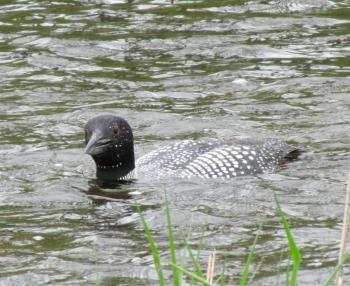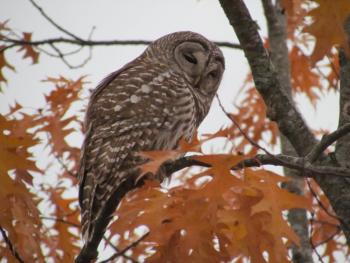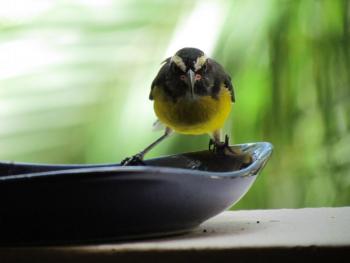Our Favorite Birds
We were wondering recently if it is a particularly American obsession to try to decide on what is “the best” or “your favorite,” or to come up with “top ten” lists. Do other cultures around the world spend so much time thinking about such comparisons?
Perhaps so. “What’s your favorite bird?” is one “favorite”-type question we get asked a lot. It’s a fun question to ask, but a hard one to answer. The name of our book, “Maine’s Favorite Birds,” kind of helps make the point about how hard it is to choose just one!
Maybe the answer is straightforward for some people but not for either of us. We have so many favorite birds. Today perhaps it would be the gorgeous white-and-black speckled young sanderlings that we watched picking at the barnacles among the yellow-orange ledges dodging frothy waves in the golden light of evening at Pemaquid Point. Sanderlings usually stick almost exclusively to beaches, where they run back and forth as the waves comes and go. These two birds were hatched this past summer somewhere in their high Arctic breeding range (juveniles have a distinctive plumage from adults). Clearly they still had something to learn about the beach-loving habits of their species.
Or maybe today’s favorite is the pair of Caspian terns that flew by us as we stood beside the famous white lighthouse at Pemaquid. These are enormous terns, larger than some of our gulls; their large, reddish-orange bills look like carrots. Caspian terns have a special place in our hearts from our time in Ithaca, New York, where groups of them would hang out in late summer at the south end of 40-mile-long Cayuga Lake. On many a hot, humid summer evening walk along the shore of Alan Treman Park we would see them roosting on the lighthouse jetty.
A few days before this, we might have named the common nighthawk as our favorite bird. We had stopped at a boat landing in Harspwell to count the number of these sharp-winged flyers bounding south in migration. In about 30 minutes we counted more than 250. In a few weeks they will be in South America.
Back in early August, we would certainly have had to count the barred owl and the common loon as two of our favorites. We were staying at a family member’s lakeshore camp for a few days, where the lonely cries of loons echoed regularly across the still lake. While out canoeing and kayaking several loons popped up quietly near us, watching us as we watched them, their gorgeous black heads gleaming in the sun. One night at the camp, a family of barred owls hooted manically from the tall dark trees around us: “who-cooks-for-you, who-cooks-for-you-all.” A young one could be heard giving their distinctive hissing cries.
Earlier this summer, we were enamored with the gang of young blue jays, perhaps having left the nest just weeks earlier, that together were learning the ways of the world just outside our kitchen windows. It was so fun to see them exploring new things for the first time like the wooden clothes pins on our laundry line and the bird feeder in the lilac. Occasionally they would squawk and fight amongst themselves or flutter their wings and beg with the hope that one of their parents might still feed them.
And we haven’t even started with the wonderful and memorable birds we have seen across the U.S. and the world over the years. The beloved bananaquits that love to come to offerings of sweet syrup in the Caribbean? We wrote about them and many other favorites in our book, "Birds of Aruba, Bonaire, and Curacao: A Site and Field Guide" The red-cockaded woodpeckers making their friendly squeaky-toy sounds in the fragrant pines of Florida? The tiny green kingfisher we spotted at Santa Ana National Wildlife Refuge along Rio Grande of South Texas or the whooping cranes we saw stalking in the marshes at Aransas National Wildlife Refuge on the Texas coast? Maybe it would be the prehistoric looking greater roadrunner we saw in a dry canyon in southern California?
The truth is, they are all our favorites. May it be that way for all of you, too.
Jeffrey V. Wells, Ph.D., is a Fellow of the Cornell Lab of Ornithology and Vice President of Boreal Conservation for National Audubon. Dr. Wells is one of the nation's leading bird experts and conservation biologists and author of “Birder’s Conservation Handbook”. His grandfather, the late John Chase, was a columnist for the Boothbay Register for many years. Allison Childs Wells, formerly of the Cornell Lab of Ornithology, is a senior director at the Natural Resources Council of Maine, a nonprofit membership organization working statewide to protect the nature of Maine. Both are widely published natural history writers and are the authors of the book, “Maine’s Favorite Birds” and “Birds of Aruba, Bonaire, and Curaçao: A Site and Field Guide” from Cornell Press.
































